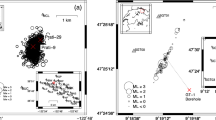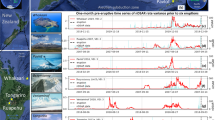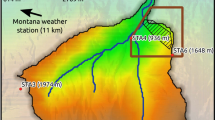Abstract
THE 'materials science' method for eruption prediction1–3 arises from the application of a general law governing the failure of materials: Ω⊙−α Ω¨ − A = 0, where A and α are empirical constants, and Ω is an observable quantity such as ground deformation, seismicity or gas emission. This law leads to the idea of the 'inverse-rate' plot, in which the time of failure can be estimated by extrapolation of the curve of Ω−1 versus time to a pre-deter-mined intercept. Here we suggest that this method can be combined with real-time seismic amplitude monitoring to provide a tool for near-real-time eruption prediction, and we demonstrate how it might have been used to predict two dome-growth episodes at Mount St Helens volcano in 1985 and 1986, and two explosive eruptions at Redoubt volcano in 1989–90.
This is a preview of subscription content, access via your institution
Access options
Subscribe to this journal
Receive 51 print issues and online access
$199.00 per year
only $3.90 per issue
Buy this article
- Purchase on Springer Link
- Instant access to full article PDF
Prices may be subject to local taxes which are calculated during checkout
Similar content being viewed by others
References
Voight, B. Nature 332, 125–130 (1988).
Voight, B. Science 243, 200–203 (1989).
Tilling, R. I. Nature 332, 108–109 (1988).
Tokarev, P. I. Bull. Volcan. 35, 243–250 (1971).
Tokarev, P. I. in Forecasting Volcanic Events (eds Tazieff, H. & Sabroux, J.-C.) Ch. 9 (Elsevier, Amsterdam, 1983).
Shimozuru, D. in The Surveillance and Prediction of Volcanic Activity, 19–45 (UNESCO, Paris, 1972).
Minakami, T. in Physical Volcanology (eds Civetta, L., Gasparini, P., Luongo, G. & Rapollo, A.) 313–333 (Elsevier, Amsterdam, 1974).
Malone, S. et al. Science 221, 1376–1378 (1983).
Swanson, D. A. et al. J. Geodynam. 3, 397–423 (1985).
Decker, R. W. Ann. Rev. Earth planet. Sci. 14, 267–291 (1986).
Endo, E. T. & Murray, T. Bull. Volcanology (in the press).
Sassa, K. Mem. Coll. Sci. Kyoto Univ. 19, 11–56 (1936).
Schick, R. et al. J. Volcan. geotherm. Res. 14, 261–279 (1982).
Nishi, K. Annls Disaster Prev. Res. Inst. Japan B 30, 1–18 (1990).
Okada, H. Bull. Volcan. Soc. Japan 35, 175–203 (1990).
Murray, T. & Endo, E. T. US geol. Surv. Open File Rep. 89–684 (1989).
Stephens, C. D. et al. EOS (in the press).
Fehler, M. J. geophys. Res. 88, 3476–3484 (1983).
Endo, E. T., Dzurisin, D. & Swanson, D. A. in Magma Transport and Storage (ed. Ryan, M. P.) Ch. 15 (Wiley, Chichester, 1990).
Alaska Volcano Observatory EOS 71, 265–275 (1990).
Author information
Authors and Affiliations
Rights and permissions
About this article
Cite this article
Voight, B., Cornelius, R. Prospects for eruption prediction in near real-time. Nature 350, 695–698 (1991). https://doi.org/10.1038/350695a0
Received:
Accepted:
Issue Date:
DOI: https://doi.org/10.1038/350695a0
This article is cited by
-
Volcanic soil gas 4He/CO2 ratio: a useful geochemical tool for real-time eruption forecasting
Scientific Reports (2024)
-
Towards scientific forecasting of magmatic eruptions
Nature Reviews Earth & Environment (2023)
-
Seismic background level (SBL) growth can reveal slowly developing long-term eruption precursors
Scientific Reports (2023)
-
Dynamic rupture forewarned by a displacement field criterion
International Journal of Fracture (2023)
-
Data analysis of the unsteadily accelerating GPS and seismic records at Campi Flegrei caldera from 2000 to 2020
Scientific Reports (2022)
Comments
By submitting a comment you agree to abide by our Terms and Community Guidelines. If you find something abusive or that does not comply with our terms or guidelines please flag it as inappropriate.



